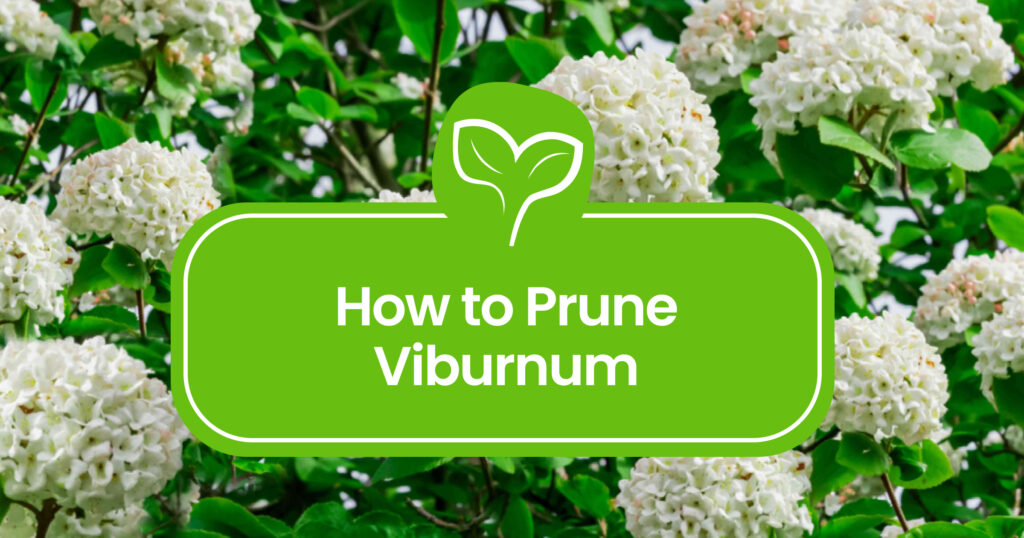
Ready to dive into the world of pruning viburnum? Whether you’re a green-thumbed pro or just dipping your toes into gardening, mastering the art of pruning can take your viburnum shrubs to the next level of beauty and health. In this article, we’ve got all the juicy details you need, from the best timing and essential tools to easy-to-follow techniques for different varieties.
Whether you’re aiming to shape, rejuvenate, or simply spruce up your viburnum, we’ve got everything to help you out. So grab your favorite pair of pruning shears and let’s learn how to prune Viburnum the right way!
When to Prune Viburnum:
Timing is pretty important when it comes to pruning your viburnum. Aim for the dormant season, usually in late winter, for any major pruning. This is when your Viburnum is resting, making it the perfect time for shaping and rejuvenation without disturbing new growth.
You can also prune after the shrub has finished flowering in late summer. Just be sure to get in there before new buds start forming to avoid cutting off next season’s blossoms.
The Tools You’ll Need
Before you begin pruning, gather, clean and sharpen your tools.
- Pruning Shears: Perfect for precision cuts on smaller branches, these shears offer sharp blades and a comfy grip.
- Loppers: Ideal for thicker branches and high-reaching spots, loppers provide extra leverage with long handles.
- Pruning Saw: Tackle tough jobs with ease using a pruning saw’s sharp teeth and sturdy blade.
- Protective Gloves: Keep your hands safe from scratches and thorns with snug-fitting, durable gloves.

Pruning Viburnum Step-by-Step
Now, let’s dive into the step-by-step process of pruning viburnum:
- Remove Any Dead and Damaged Parts: Start by getting rid of any branches that fall into the ‘three Ds’ category: dead, damaged, or diseased. Also, toss in any weak, spindly branches or ones growing inward, cluttering up the bush’s interior. For tough old wood, grab some long-handled loppers and a sharp folding pruning saw to make the job easier.
- Remove Dead Flowers: Snip away those spent blossoms with sharp, clean pruners. Cut the stems back to a healthy leaf node or bud to encourage new growth for next spring’s blooms. Keep an eye out for any signs of pests or disease, and if you spot any, get rid of those branches pronto.
- Cut Away Old And Unproductive Wood: Next up, tackle those thicker stems that have grown a bit lanky and aren’t producing like they used to. Use your loppers or pruning saw to trim ’em down, but don’t go overboard—wait until next year to take off more. Leave a little stub about an inch long when you make your cuts so a healing callus can form naturally.
Pruning Different Viburnum Varieties
Not all viburnum varieties should be pruned the same way. Shrubby varieties may need light, selective pruning to be kept in shape, while tree-form viburnums may benefit from more extensive pruning to control their size.
Pruning Snowball Viburnum

Snowball Viburnums burst into bloom on old wood, meaning you need to hold off on any pruning until after they’ve strutted their stuff with those gorgeous flowers. Once they’re done showing off, feel free to give them a little trim to tidy things up. Just make sure to leave a bit of space when you’re making cuts, about a quarter inch from where the branch meets another or the trunk. And hey, if you’re looking to rejuvenate an older shrub, go ahead and give it a good trim, but keep in mind it might take a year or two for it to start blooming again.
Pruning Tree-Forming Viburnums
If you’ve got a young viburnum that’s still under 2 feet tall, here’s what you need to do: wait until late winter when it is resting, then pick out the healthiest trunks or main branches—about 1 to 3 of them—and snip off the rest. Let your viburnum grow a bit, at least to 4 feet tall, before you start prunin’ the lower branches to shape it into a tree.
The same goes for older viburnums: pick out 1 to 3 sturdy trunks or main branches to form your tree shape. Then, give them a good trim to keep things lookin’ sharp. As your tree grows, gradually prune off those lower branches, keeping an eye on that balance between the canopy and trunk.
Keep heavy pruning sessions for late winter to avoid hurting fresh growth.
Aftercare
After giving your viburnums a nice trim, they don’t need a whole lot of fuss, but here’s a little TLC tip:
- treat them to some tree and shrub fertilizer, like the one from BioAdvanced on Amazon. Just follow the instructions on the label, and your viburnums will be ready to rock their growing season.
- After that, a cozy layer of mulch will keep the moisture in and give those roots a tasty nutrient boost.

Frequently Asked Questions
When to prune Viburnum shrubs?
The best times to prune are during the dormant season, typically in late winter, or after the shrub has finished flowering in late summer. This way you won’t accidentally trim away future blossoms.
Can viburnum be cut back hard?
If your viburnum is getting out of hand or looking a bit too leggy for your liking, a hard prune might just be the ticket. This means cutting back those larger, unsightly branches to thin out the shrub and give it a fresh start.
How often should you prune Viburnum?
Viburnums usually don’t need much pruning unless they’re getting too crowded or old. After flowering, if shaping is necessary, go ahead and give them a trim. Otherwise, a light prune every 2 or 3 years should keep them in top shape!
Can I prune viburnum during the summer months?
If you want to prune Viburnum in the summer, aim for the later months, after the shrub has finished flowering.

